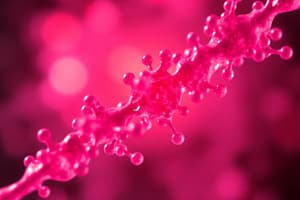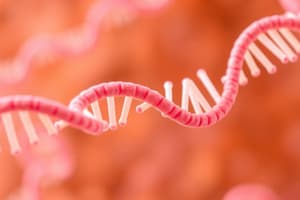Podcast
Questions and Answers
What is the primary role of mRNA in the process of translation?
What is the primary role of mRNA in the process of translation?
- To stabilize the structure of the ribosome
- To bind amino acids during protein synthesis
- To carry genetic information from DNA to ribosomes (correct)
- To catalyze the formation of peptide bonds
Which of the following correctly describes the relationship between DNA codons and RNA anticodons?
Which of the following correctly describes the relationship between DNA codons and RNA anticodons?
- DNA codons match RNA codons directly
- RNA codons are identical to DNA codons
- DNA codons and RNA anticodons have no interaction
- RNA anticodons are complementary to DNA codons (correct)
What distinguishes coding (gene) strands from template strands in DNA?
What distinguishes coding (gene) strands from template strands in DNA?
- Template strands are never used during transcription
- Coding strands are identical to the resulting mRNA (correct)
- Coding strands are always more abundant than template strands
- Template strands contain more genetic information
In which direction are DNA strands typically read during transcription?
In which direction are DNA strands typically read during transcription?
What role does tRNA play in translation?
What role does tRNA play in translation?
Which of the following statements about rRNA is correct?
Which of the following statements about rRNA is correct?
How are amino acids incorporated into a growing polypeptide chain during translation?
How are amino acids incorporated into a growing polypeptide chain during translation?
Which of the following is a key characteristic of DNA strands?
Which of the following is a key characteristic of DNA strands?
What is the primary role of enzymes in biochemical reactions?
What is the primary role of enzymes in biochemical reactions?
Which factor does NOT affect enzyme activity?
Which factor does NOT affect enzyme activity?
How does the induced-fit model explain enzyme-substrate binding?
How does the induced-fit model explain enzyme-substrate binding?
Which of the following factors can increase the rate of an enzyme-catalyzed reaction?
Which of the following factors can increase the rate of an enzyme-catalyzed reaction?
What effect does the presence of inhibitors have on enzyme activity?
What effect does the presence of inhibitors have on enzyme activity?
Which statement is true regarding the concentrations of reactants in an enzyme-controlled reaction?
Which statement is true regarding the concentrations of reactants in an enzyme-controlled reaction?
What is a primary reason for the significance of the collaborative work of Nobel prize winners in relation to RNA-ribozymes?
What is a primary reason for the significance of the collaborative work of Nobel prize winners in relation to RNA-ribozymes?
Which type of proteins are known for their specific three-dimensional structures that facilitate molecular recognition?
Which type of proteins are known for their specific three-dimensional structures that facilitate molecular recognition?
What distinguishes an enzyme from a substrate?
What distinguishes an enzyme from a substrate?
Why is the three-dimensional shape of a protein critical to its function?
Why is the three-dimensional shape of a protein critical to its function?
What happens when the temperature increases beyond an enzyme's optimal range?
What happens when the temperature increases beyond an enzyme's optimal range?
Which category of proteins primarily functions in cell signaling and communication?
Which category of proteins primarily functions in cell signaling and communication?
What role do antibodies play among the different types of proteins?
What role do antibodies play among the different types of proteins?
Which of the following statements about enzymes is true?
Which of the following statements about enzymes is true?
What is an example of a protein that can act as a receptor in cell membranes?
What is an example of a protein that can act as a receptor in cell membranes?
How do enzymes achieve specificity for their substrates?
How do enzymes achieve specificity for their substrates?
What distinguishes prokaryotic cells in terms of their structure compared to eukaryotic cells?
What distinguishes prokaryotic cells in terms of their structure compared to eukaryotic cells?
Which of the following aspects is common to both prokaryotic and eukaryotic cells?
Which of the following aspects is common to both prokaryotic and eukaryotic cells?
What is the typical shape and location of chromosomes in prokaryotic cells?
What is the typical shape and location of chromosomes in prokaryotic cells?
How do prokaryotic cells primarily exist in terms of cellular structure?
How do prokaryotic cells primarily exist in terms of cellular structure?
Which statement accurately reflects the evolutionary aspects of prokaryotic and eukaryotic cells?
Which statement accurately reflects the evolutionary aspects of prokaryotic and eukaryotic cells?
What size range typically characterizes prokaryotic cells?
What size range typically characterizes prokaryotic cells?
What does the internal organization of prokaryotic cells lack compared to eukaryotic cells?
What does the internal organization of prokaryotic cells lack compared to eukaryotic cells?
Which feature is NOT typically associated with prokaryotic cells?
Which feature is NOT typically associated with prokaryotic cells?
What is the primary function of the nucleus in a cell?
What is the primary function of the nucleus in a cell?
Which function is associated with the nucleolus?
Which function is associated with the nucleolus?
What is the role of mitochondria in cells?
What is the role of mitochondria in cells?
What is the primary function of chloroplasts?
What is the primary function of chloroplasts?
What is the primary function of vacuoles in plant cells?
What is the primary function of vacuoles in plant cells?
What is the role of the Golgi body?
What is the role of the Golgi body?
What distinguishes rough endoplasmic reticulum from smooth endoplasmic reticulum?
What distinguishes rough endoplasmic reticulum from smooth endoplasmic reticulum?
Which function is primarily performed by lysosomes?
Which function is primarily performed by lysosomes?
Flashcards are hidden until you start studying
Study Notes
The Role of Nucleic Acids in Transcription and Translation
- DNA: The blueprint of life; contains genetic information in the form of a double helix structure.
- mRNA: Messenger RNA; carries genetic instructions from DNA to ribosomes for protein synthesis.
- tRNA: Transfer RNA; carries specific amino acids to ribosomes based on mRNA codons.
- rRNA: Ribosomal RNA; a major component of ribosomes, essential for protein synthesis.
The Relationship Between DNA Codons, RNA Codons, Anticodons, and Amino Acids
- DNA codons: Three-nucleotide sequences on DNA that code for specific amino acids.
- RNA codons: Three-nucleotide sequences on mRNA that correspond to DNA codons and also code for specific amino acids.
- Anticodons: Three-nucleotide sequences on tRNA that are complementary to mRNA codons, ensuring the correct amino acid is brought to the ribosome.
- Amino acids: Building blocks of proteins, linked together based on the sequence of mRNA codons.
Coding and Template Strands of DNA
- Coding Strand: The DNA strand that has the same sequence as the mRNA molecule (except thymine is replaced with uracil).
- Template Strand: The DNA strand used as a template for mRNA synthesis during transcription; it's complementary to the coding strand.
Directionality of DNA Strands
- 5' to 3' direction: DNA strands have directionality, meaning they are read from the 5' end to the 3' end.
The Significance of RNA Ribozymes
- Ribozymes are catalytic RNA molecules that can act as enzymes.
- Nobel Prize winners have contributed significantly to our understanding of ribozymes, highlighting RNA’s catalytic properties.
Proteins and Their Three-Dimensional Structure
- Proteins are essential for cell structure and function.
- Enzymes: Catalyze biochemical reactions.
- Hormones: Chemical messengers.
- Receptor Proteins: Bind to specific molecules.
- Antibodies: Defend against pathogens.
- Specific shapes: The intricate three-dimensional structure of proteins allows them to recognize and bind specific molecules, facilitating their functions.
Importance of Protein Shape
- Enzyme Specificity: Enzymes have specific shapes that allow them to interact with specific substrates, influencing reaction rates.
- Induced-Fit Model: The enzyme's shape slightly changes upon substrate binding, optimizing binding and catalysis.
Factors Affecting Enzyme Activity
- Enzymes are affected by several factors:
- Temperature: Optimal temperature for each enzyme; high temperatures can denature enzymes.
- pH: Optimal pH for each enzyme; pH changes can affect enzyme activity by altering the shape of the enzyme.
- Inhibitors: Molecules that can block enzyme activity by binding to the active site or other parts of the enzyme.
Factors Affecting Enzyme-Controlled Reaction Rates
- Reactant Concentrations: Higher concentrations of reactants lead to faster reaction rates.
- Enzyme Concentration: Higher enzyme concentrations lead to faster reaction rates.
Prokaryotic and Eukaryotic Cells
- Evolutionary Past: Prokaryotes and eukaryotes share common features due to their shared evolutionary history.
Differences Between Prokaryotic and Eukaryotic Cells
- Size: Prokaryotes are generally smaller than eukaryotes.
- Internal Organization: Prokaryotes lack membrane-bound organelles, while eukaryotes have a complex internal organization.
- Shape and Location of Chromosomes: Prokaryotes have a single circular chromosome located in the cytoplasm (nucleoid region). Eukaryotes have multiple linear chromosomes located within the nucleus.
Prokaryote Examples
- Prokaryotes exist solely as single cells.
Eukaryotic Cell Organelles
- Nucleus: Contains the cell's genetic material (DNA) and controls cellular activities.
- Nucleolus: Located within the nucleus, responsible for ribosome synthesis.
- Mitochondrion: Powerhouse of the cell; responsible for cellular respiration and ATP production.
- Chloroplast: Found in plant cells, responsible for photosynthesis.
- Vacuole: Storage organelle for water, nutrients, and waste products.
- Golgi Body: Processes and packages proteins and lipids for secretion or other uses within the cell.
- Endoplasmic Reticulum (ER): Network of membranes involved in protein and lipid synthesis.
- Rough ER: studded with ribosomes, involved in protein synthesis.
- Smooth ER: lacks ribosomes, involved in lipid synthesis, detoxification, and calcium storage.
- Ribosome: Site of protein synthesis.
- Lysosome: Contains digestive enzymes to break down cellular waste and debris.
- Cytoskeleton: Network of protein filaments that provides structural support, cell shape, and aids in movement.
Studying That Suits You
Use AI to generate personalized quizzes and flashcards to suit your learning preferences.




